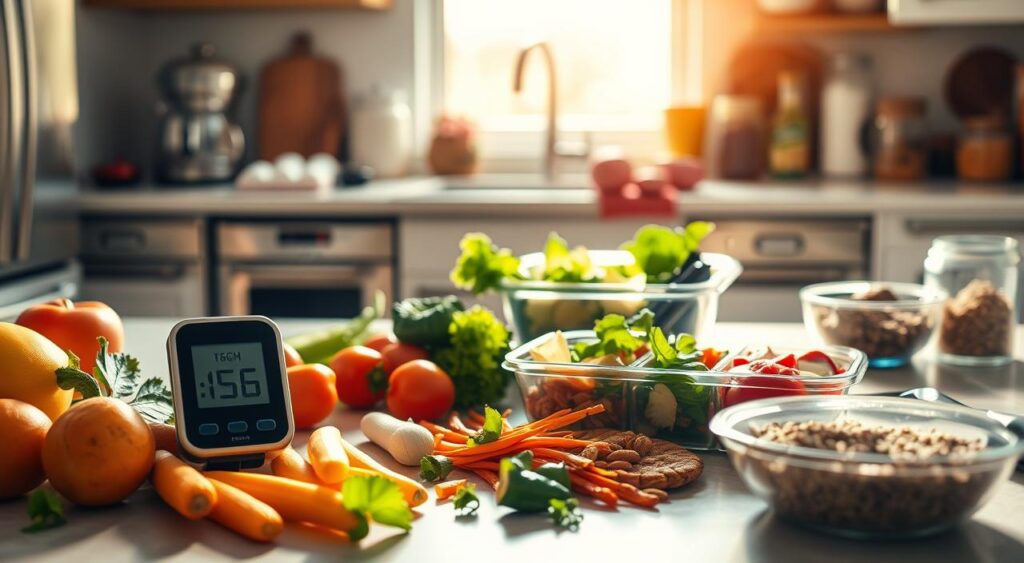Ever thought a patch on your arm could show you the best meals for weight loss? Or which ones make your blood sugar drop?
A continuous glucose monitor diet lets you watch your glucose levels in real time. This way, you can adjust your eating habits. CGM diets offer up to 288 readings a day, giving you constant glucose insights. This can help you stay in a healthy glucose range and lower your average glucose levels.
People using CGMs from brands like FreeStyle Libre, Dexcom, and Medtronic see clear changes in their habits. They also see big A1C improvements in studies. This guide helps you set up a CGM system, read your trends, plan meals, and time exercise and sleep for steady blood sugar.
Here’s practical advice—device choices, data interpretation, foods to eat or avoid, and meal prep tips. Use your data to eat smarter and keep your metabolic health in check.
What is a CGM-Guided Eating?
A continuous glucose monitoring system gives you near real-time insight into how your body responds to food, activity, and stress. It’s not just single fingerstick snapshots. A CGM collects dozens to hundreds of readings each day. This way, you can see trends and make smarter choices about meals and movement.
Understanding CGM Technology
You wear a small sensor with a tiny filament that sits just under the skin. It measures glucose in the interstitial fluid. Popular devices include Abbott FreeStyle Libre, Dexcom, and Medtronic systems.
The sensor links to a transmitter that sends data to a phone or receiver app. Readings reflect interstitial glucose, so they lag blood glucose levels by roughly 5–15 minutes. Accuracy is commonly reported using MARD, which for modern sensors tends to fall in the mid single digits to low teens percent range.
Benefits of Using a CGM
With continuous trend data, you can catch post-meal spikes, overnight dips, and patterns you would miss with intermittent testing. Alerts notify you of highs and lows so you can act before bigger problems develop.
Research shows CGMs can improve time in range, lower A1C for many users, and boost motivation to change behavior. People with diabetes benefit most, but athletes, those with prediabetes, and anyone following a continuous glucose monitor diet for metabolic goals can gain useful feedback.
How CGMs Work
The sensor measures glucose in the interstitial fluid and the transmitter streams that data to an app or dedicated receiver. Some systems link to insulin pumps or closed-loop setups to automate delivery based on sensed trends.
Limitations include the measurement lag versus blood, occasional interference from temperature or compression, and slightly lower precision than laboratory blood tests. Factors like intense exercise, stress, and sleep can affect readings. So, you should interpret data in context when planning a continuous glucose monitor diet or tracking blood glucose levels.
How CGMs Influence Your Diet Choices
Using a continuous glucose monitor changes how you plan meals. You get immediate feedback on foods that cause large spikes and foods that keep levels steady. Small tests—like eating fruit alone, then the same fruit with nuts—let you compare real responses and refine a blood sugar monitoring diet that fits your life.
Real-Time Blood Sugar Tracking
When you wear a CGM you see post-meal peaks in real time. Aim to keep peaks under about 8 mmol/L (144 mg/dL) and return close to baseline within roughly two hours when you can. Many users target a Time in Range of 4–6 mmol/L or a personalized range at 70% or higher to support a glucose control diet.
Test a meal, then try small swaps: whole-grain bread versus white bread, or adding protein and fat to blunt a rise. Repeat those trials to learn which combinations work for you. This trial-and-error approach is the backbone of a practical continuous glucose monitor diet.
The Importance of Data Analysis
Key metrics help you read the story behind numbers. Watch Time in Range, average glucose, and variability. A coefficient of variation at or below 30% signals more stable glucose. Use 14-day AGP-style summaries to spot patterns that single readings miss.
Pair CGM traces with a food log or an app that syncs meals and activity. That pairing improves your ability to link spikes to specific foods, meal timing, or exercise. Automated meal-detection tools show promise, but detection times vary, which affects how quickly you can act.
If you want deeper context, review evidence-based nutrition approaches alongside CGM insights. A recent research effort outlines how combining nutrition guidance with CGM initiation targets behavior change and glycemic outcomes; learn more in this report on CGM and nutrition.
- Use short experiments to refine your blood sugar monitoring diet.
- Track TIR and variability to shape a sustainable glucose control diet.
- Combine CGM trends with meal logs for actionable guidance on a continuous glucose monitor diet.
Getting Started with CGM for Diet Management
Starting a continuous glucose monitor diet plan can feel overwhelming. This guide helps you pick a device and set up a continuous glucose monitoring system. You can then use data to shape your blood sugar monitoring diet.
Choosing the Right CGM Device
Consider accuracy, wear time, sensor cost, and app compatibility with your phone. Popular choices include FreeStyle Libre and Dexcom G6/G7. Medtronic offers clinical options for those needing insulin pump support.
Decide if you need real-time alerts or an intermittent-scanning device. Real-time CGMs send alerts, which can be safer if you adjust insulin. If you prefer occasional checks, an isCGM might be better for you.
Check insurance coverage and prescription rules in the United States. Medicare and private insurers have different coverage. Manufacturers often offer patient-assistance programs to lower costs.
Setting Up Your CGM System
Choose a sensor site based on the device instructions. Many place sensors on the upper arm or abdomen. Sensors last 10–14 days, but duration varies by brand. Rotate sites to avoid skin irritation.
Follow calibration guidance. Many systems arrive factory-calibrated and need no fingerstick checks. If your model requires calibrations, do them as directed for reliable readings.
Pair the sensor with its smartphone app and enable trend notifications. Set personalized target ranges with your clinician. Export 14-day AGP reports to review with your care team. Keep a short meal log for the first two weeks to match meals with glucose responses.
Learn the device’s alert thresholds and expect some lag between blood and interstitial glucose. Avoid reacting to a single reading; use trends to guide your blood sugar monitoring diet choices over time.
Interpreting Your Glucose Data
Start by scanning your continuous glucose monitor diet reports for repeatable signals. Small patterns tell big stories. Look for when your blood glucose levels rise, fall, and stay within range. Use these clues to plan smarter meals and activity.
Understanding Glucose Patterns
Look for post-meal spikes and note how quickly they peak. Some meals push glucose up within 30 to 60 minutes, while others show delayed rises. Compare similar meals to see how portion size, fat, protein, and fiber change the response.
Watch overnight trends and morning fasting highs. The dawn phenomenon can create higher morning readings. Exercise can cause drops or short spikes depending on intensity and timing.
Use core metrics like Time in Range (aim for 70% or more for many people), average glucose, and coefficient of variation (target ≤30%). These numbers help you judge stability and risk.
Using Trends to Inform Your Choices
Turn observed trends into simple tests. Pair a high-GI food with nuts or yogurt and note the difference. Try white rice alone one day and rice with beans another day to see how your blood glucose levels respond.
Keep variables steady while you test. Match activity, portion sizes, and meal timing so results are meaningful. Track changes across two-week windows to spot reliable shifts.
Use the data to tweak meals and schedule. Move dinner earlier to reduce overnight peaks. Shrink portions of high glycemic load items or add fiber and protein to blunt spikes. If you use glucose monitoring for weight loss, these practical swaps can improve satiety and control.
| Pattern | What to Check | Actionable Change |
|---|---|---|
| Rapid post-meal spike | Time-to-peak within 30–60 minutes; high GI carbs | Add protein or healthy fat, reduce portion size, try whole-grain swap |
| Delayed rise | Peak after 60–120 minutes; mixed meals with fat | Test smaller portions or different meal order; monitor for slower digestion |
| Morning fasting high | Dawn phenomenon, hormone-driven rise | Shift evening carbs earlier; evaluate medication timing with clinician |
| Exercise-related drop or spike | Intensity and timing of workouts | Adjust pre/post-exercise snacks; try different workout times |
| Low Time in Range | TIR below target; high variability | Review overall meal patterns; use continuous glucose monitor diet data to guide gradual changes |
Share Aggregate Glucose Profile reports with your clinician when you need personalized targets or medication adjustments. Regular review of trends turns raw numbers into a practical plan for better control and effective glucose monitoring for weight loss.
Foods to Include for Stable Blood Sugar Levels
Using a continuous glucose monitor diet helps you make better food choices. Look for foods that lower blood sugar spikes, keep you full, and meet your diet goals.
Low glycemic index foods
Opt for fruits like apples and berries, and legumes like lentils and chickpeas. Non-starchy vegetables and whole grains like barley and steel-cut oats are also good. These foods cause blood sugar to rise more slowly than white bread or rice.
Fiber-rich choices
Fiber slows down how carbs are absorbed, which helps prevent big blood sugar spikes. Include foods high in fiber like oats, beans, chia seeds, and vegetables in your meals. Adding a side salad or extra veggies can also help.
Healthy fats and proteins
Lean proteins like chicken, fish, tofu, and eggs don’t raise blood sugar much. Healthy fats from avocado, nuts, and olive oil also help. Try pairing an apple with peanut butter or whole-grain toast with avocado and eggs.
Be mindful of portion sizes and how foods mix together. Adding 35 grams of fat can change how quickly blood sugar rises. Use your continuous glucose monitor diet to test and adjust your food choices.
If you’re managing diabetes, consider glycemic load when planning meals. Glycemic load combines GI with portion size to predict how foods will affect you. Track your meals with your CGM and adjust your diet to keep your blood sugar stable.
Foods to Avoid for Better Stability
Using a continuous glucose monitor diet helps you spot foods that cause spikes. Avoiding these foods can make your glucose levels more stable.

High-Glycemic Choices
Foods with a glycemic index of 70 or higher can raise your glucose quickly. White bread, rice cakes, and some potatoes are examples. Be careful with portion sizes because the glycemic load increases with the amount eaten.
Choose lower-GI foods like barley, sweet potatoes, or whole-grain bread instead. Adding protein or healthy fats to high-GI foods can help manage spikes.
Sugary Snacks and Beverages
Sweetened sodas, energy drinks, and large fruit juices can cause quick spikes. A 12-oz soda has about 40 grams of sugar. Flavored yogurts and sweet cereals often have hidden sugars.
Reducing or replacing these items can improve your blood sugar monitoring diet. Try plain Greek yogurt with berries or sparkling water with lemon instead.
Processed Carbohydrates
Refined carbs like instant oatmeal packets, many granola bars, and fast-food sides can cause variability. These foods digest quickly and often have extra sweeteners.
Opt for whole grains like quinoa, steel-cut oats, or legumes. These choices help stabilize your glucose levels and make tracking easier.
Creating a Personalized Meal Plan
Use your CGM results to shape a meal plan that fits your life and goals. Start with a short log of meals, portions, and pre- and post-meal glucose for one to two weeks. This habit helps you spot which foods cause spikes and which keep levels steady.
Using Your CGM Data
Build your daily menus around foods and combinations that produce smaller spikes and faster recovery on your device. Track Time in Range and variability. Set simple weekly targets, like increasing Time in Range by a few percentage points or cutting the number of peaks above 140 mg/dL.
Logging gives evidence you can act on. If whole-grain toast with peanut butter causes a smaller rise than a bagel, favor the first. Use glucose monitoring for weight loss experiments to see which swaps lower peaks while keeping you satisfied.
Adjustments Based on Your Lifestyle
Tune carbohydrate amounts to match your activity. On active days, higher-carb meals often perform better. On rest days, reduce portion size or pair carbs with protein and fiber.
Compare CGM responses on workout days versus sedentary days to refine choices. Account for life stages and special situations. Pregnancy, menopause, and shift work change how your body handles glucose.
If you take diabetes medications or insulin, coordinate changes with your clinician. Never adjust insulin dosing without medical guidance.
Experimenting with Meal Timing
Test early versus late dinners to find what stabilizes your glucose. Eating later at night can raise peaks for some people. Try swapping dinner from 9–10 PM to 6–7 PM and watch your CGM trends.
Use food-ordering tactics such as eating protein and fiber before carbs to blunt spikes. Trial intermittent fasting windows or earlier breakfasts and observe energy and glycemic responses. Small timing shifts reveal how meal timing affects your ability to manage blood sugar levels and support glucose monitoring for weight loss strategies.
The Role of Exercise in Glucose Control
Exercise directly affects your blood sugar levels. When you move, your muscles absorb glucose, making your body more responsive to insulin. A continuous glucose monitor diet can show these changes in real time.

How Physical Activity Affects Blood Sugar
Aerobic exercises like walking or cycling lower glucose levels during and after. This happens because muscles use more glucose and insulin works better afterward.
Strength training and high-intensity workouts might cause short spikes in glucose. Stress hormones like adrenaline briefly raise blood sugar, but insulin sensitivity improves over time.
Check your CGM before and after exercise to spot any drops in glucose. This is important, even if you take medications that lower glucose.
Best Exercises for Glucose Management
Short walks after meals can help manage spikes. A five to twenty minute walk after eating often reduces glucose rises, as shown by glucose monitoring for weight loss data.
Resistance training strengthens muscles and improves insulin sensitivity over time. Aim for two to three sessions a week to help with glucose control and weight loss.
High-intensity interval training can greatly improve how flexible your glucose responses are. Keep a close eye on your CGM, as HIIT may cause immediate changes and require carb adjustments.
| Exercise Type | Typical Short-Term Effect | Best Use for You |
|---|---|---|
| Aerobic (walking, cycling) | Generally lowers glucose during and after activity | Post-meal walks; daily sustained sessions to reduce spikes |
| Resistance Training | May cause small immediate rise; improves insulin sensitivity long term | 2–3 weekly sessions to support weight loss and steady glucose |
| HIIT (sprints, circuits) | Can cause short-term spikes, followed by improved control | Monitor response and adjust carbs; useful for rapid fitness gains |
| Light Activity (stretching, chores) | Stabilizes glucose without strong swings | Use throughout the day to reduce prolonged rises |
Try different exercise timings and intensities with your continuous glucose monitor diet. This way, you can find out which routines work best for you. It will help you understand the link between exercise and glucose control in your weight loss plan.
Tracking Other Factors Influencing Glucose Levels
Your glucose readings show more than just what you eat. Stress, sleep, when you take medicine, and how active you are also play a part. By tracking these, you can better manage your blood sugar levels.
Keep a simple log next to your glucose data. Write down stressors, how much sleep you got, any exercise, and what you ate. Over time, you’ll notice patterns between spikes and certain activities. This turns your blood sugar monitoring into a way to change your lifestyle.
Stress Management Techniques
Stress hormones can make your blood sugar go up by telling your liver to release sugar. Your CGM might show spikes after stressful events. Try rating your stress before and after these events and check your readings.
When you see a spike, try quick stress-relief methods. Deep breathing, a short walk, meditation, or muscle relaxation can help. See which one works best by comparing your glucose before and after trying it.
Keep a log of when you feel stressed and what’s happening. Match it to your CGM data to find common stressors. Many people find fewer unexplained spikes by doing this with their continuous glucose monitor diet.
Sleep and Glucose Balance
Poor or irregular sleep can mess with how your body handles glucose. Short or broken sleep can increase diabetes risk and cause high morning glucose. Use your CGM to spot spikes or drops while you sleep.
Try to get 7–9 hours of sleep and go to bed between 10 PM and 11 PM. If you wake up with high glucose, eat more protein and healthy fats for breakfast. Avoid sugary cereals. Track your glucose over several nights to see if it changes.
If you can’t sleep well, try improving your sleep hygiene and consider getting checked for sleep apnea. Talk to your doctor about your sleep patterns to match your treatment with your diet plan.
Meal Prep Tips for CGM Users
Meal prep helps you stick to a diet that keeps your glucose stable. It prevents you from eating on impulse, which can raise your blood sugar. Try different portion sizes and food combinations to see what works for you.

Planning Ahead for Success
Make a weekly shopping list with foods like quinoa, legumes, lean proteins, and veggies. Add healthy fats like olive oil and avocado. These foods are good for your glucose levels and make meals balanced.
Use the easy plate method for meals: half veggies, a quarter protein, a quarter carbs, and a small fat. Cook proteins and veggies in bulk to save time. Label containers with carb counts if you track them closely.
Use your CGM data to plan meals and adjust portions. Write down how you feel and what your CGM shows after each meal. Over time, you’ll notice patterns that help you make better choices and avoid spikes.
Easy and Quick Recipe Ideas
For breakfast, try Greek yogurt with berries and nuts, scrambled eggs with spinach, or overnight oats. These meals are high in protein, fiber, and healthy fats.
Lunch options include grain bowls with quinoa and veggies, or large salads with chicken and avocado. These meals are easy to make and keep your glucose in check.
Dinner can be baked salmon with veggies or a stir-fry with tofu and brown rice. Snacks like apple slices with nut butter or hard-boiled eggs are also good choices.
Test each recipe with your CGM. Adjust portions or ingredients based on your CGM data. This way, your diet will become more personalized and easy to follow.
Maintaining a Balanced Approach to Eating
Using a continuous glucose monitor diet can help you build lasting habits. Your device shows patterns, not strict rules. This makes it easier to find a diet that fits your life and tastes.
Flexibility with Your Diet
Let your CGM guide you to make gradual changes. Track how your favorite snacks affect your readings. Note which swaps lower spikes.
Over time, you might find that some treats have little effect, while others cause big swings. Re-test foods as you change your exercise, sleep, or weight. Your body’s response can change with fitness gains or life stages.
If you take diabetes medications, check with your clinician before planning an occasional treat. This is to avoid unwanted highs or lows.
Enjoying Treats Mindfully
You can enjoy desserts without ruining your progress. Try smaller portions, pair sweets with nuts or yogurt, or eat treats before a walk. Use glucose monitoring for weight loss to learn which tactics cut the spike most effectively.
Practice mindful eating: slow down, notice flavors, and stop when you feel satisfied. Let the CGM confirm whether pairing a treat with protein or timing it after activity helped you manage blood sugar levels better.
| Strategy | Why it helps | How to test with CGM |
|---|---|---|
| Reduce portion size | Limits carbohydrate load and peak rise | Compare 1/2 portion vs full portion on different days |
| Pair with protein or fat | Slows digestion and blunts spikes | Eat treat with nuts and watch 2-hour curve |
| Time around activity | Exercise increases glucose uptake | Consume treat before or after a walk and compare |
| Choose swaps | Lower-glycemic options reduce excursions | Test dark chocolate with nuts versus candy bar |
| Mindful pace | Prevents overeating and large swings | Eat slowly and note glucose response |
Success Stories: Real Users’ Experiences
People who used a continuous glucose monitor diet have seen big changes. They’ve made smarter food choices and noticed steady weight changes. They also have clearer routines for meals and activity.

Testimonials on CGM impact
Many users found out what foods trigger spikes in their blood sugar. One person started eating eggs instead of pastries in the morning. Another person timed their walks after meals to see quicker results.
Surveys show that users make better food choices and are more aware of their blood sugar. They learn to test small changes without strict diets. This builds their confidence.
Lessons learned from health journeys
Everyone’s body reacts differently to food. Combining carbs with protein, fat, or fiber can help. Eating meals earlier can also lower overnight blood sugar levels.
It’s important to look at trends over time, not just one reading. Stress, sleep, and exercise can affect your blood sugar. Always talk to your doctor before making big changes.
Programs that review 14-day periods and offer coaching or app feedback lead to better results. Small, repeatable experiments with the CGM diet help you manage your blood sugar and make better choices every day.
Future Trends in CGM and Nutrition
Continuous glucose monitoring system technology is getting better. This means you’ll use real-time data more in your daily life. Sensors are now smaller, more accurate, and last longer.
They connect to your phone and wearables, so you can see trends right away. This makes tracking your diet feel more like getting feedback than logging data.
Emerging Technology in Glucose Monitoring
New tech will link CGM with machine learning and wearables. It will detect when you eat and suggest changes. This tech is getting better at spotting when you eat, thanks to research.
More people will get to use these tools. They’ll be in apps and platforms that help with your health. These tools will give you a score based on your glucose levels and more.
The Role of Data in Personalized Nutrition
Your glucose curves will help create diet plans just for you. These plans won’t follow the same rules for everyone. Data and models will guide you on what to eat and when.
This shift will help you find meals that keep your blood sugar stable. It will also help you reach your health goals.
CGM is moving from just helping people with diabetes to helping everyone. This raises questions about privacy and who will oversee this tech. You can expect tools that protect your privacy and involve doctors when needed. They should also make healthy eating accessible to more people.














